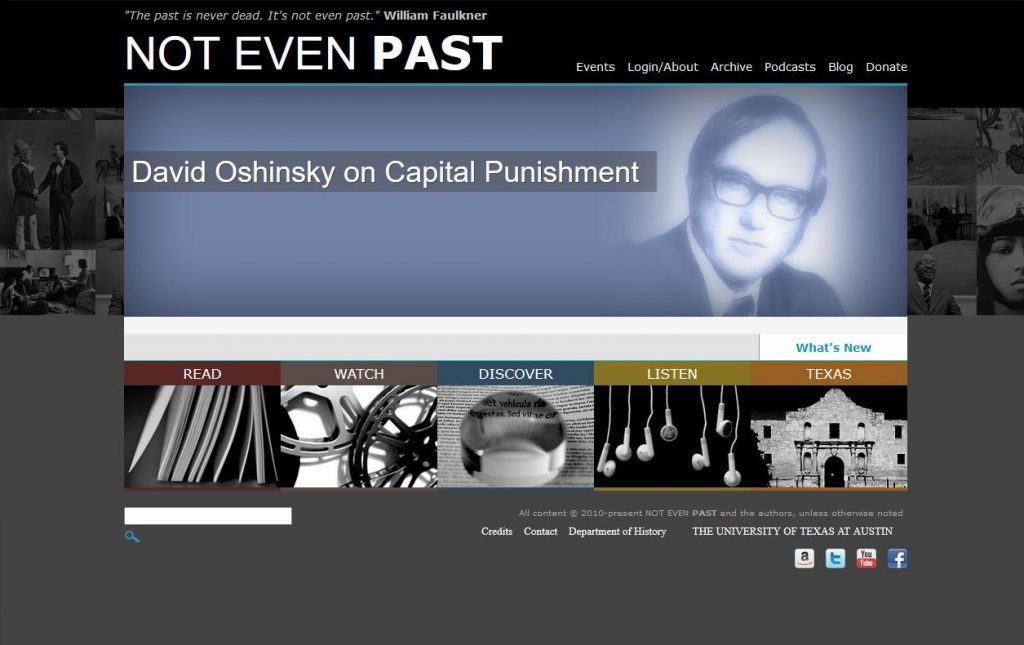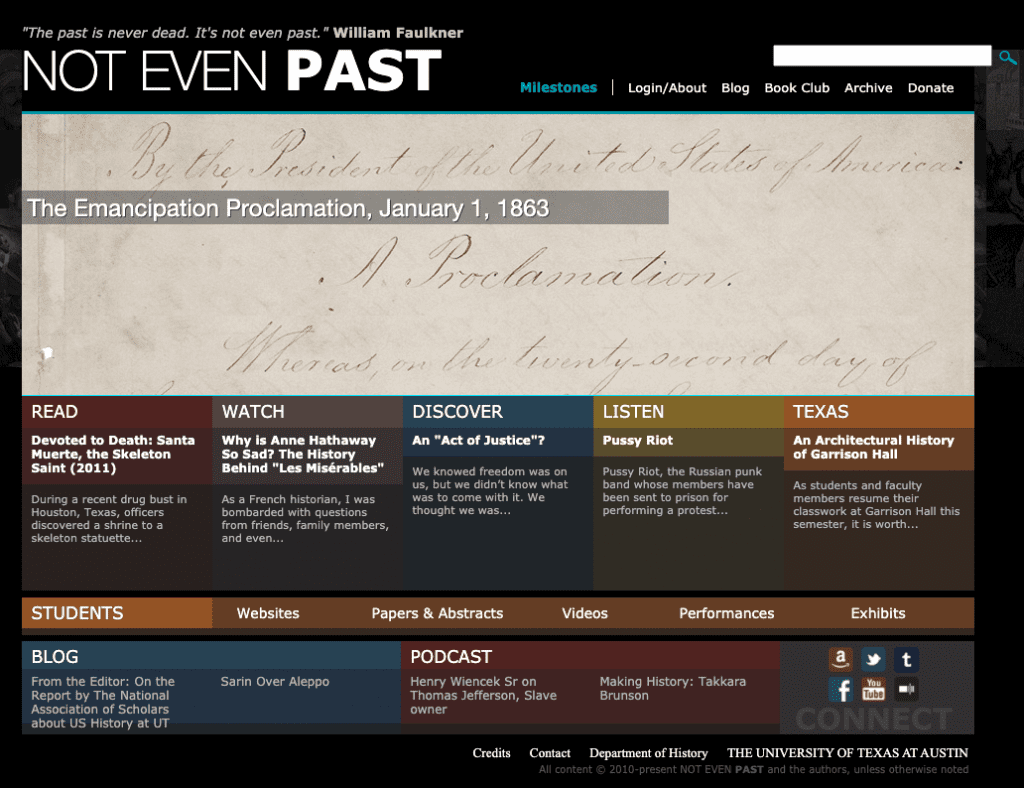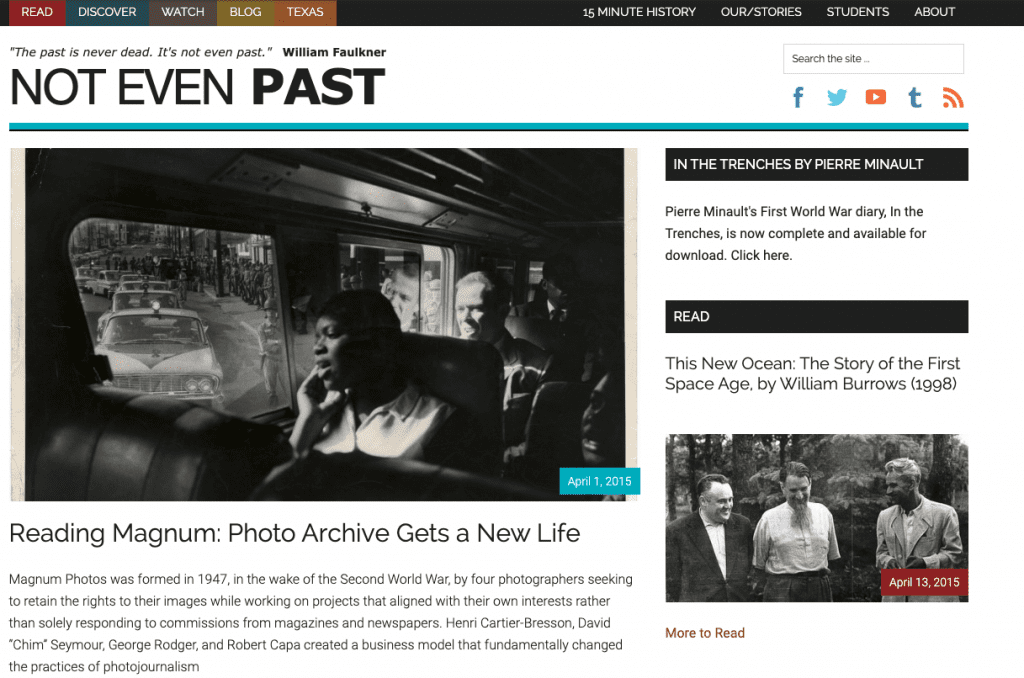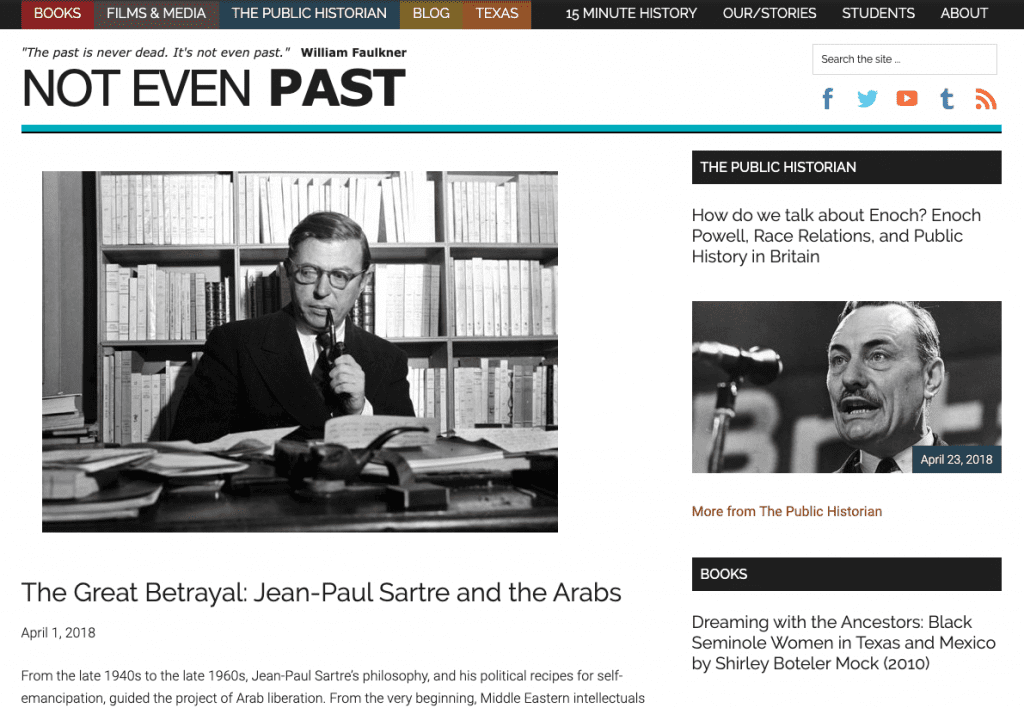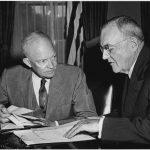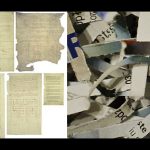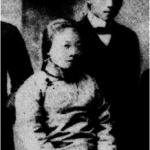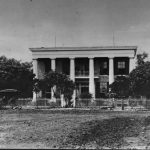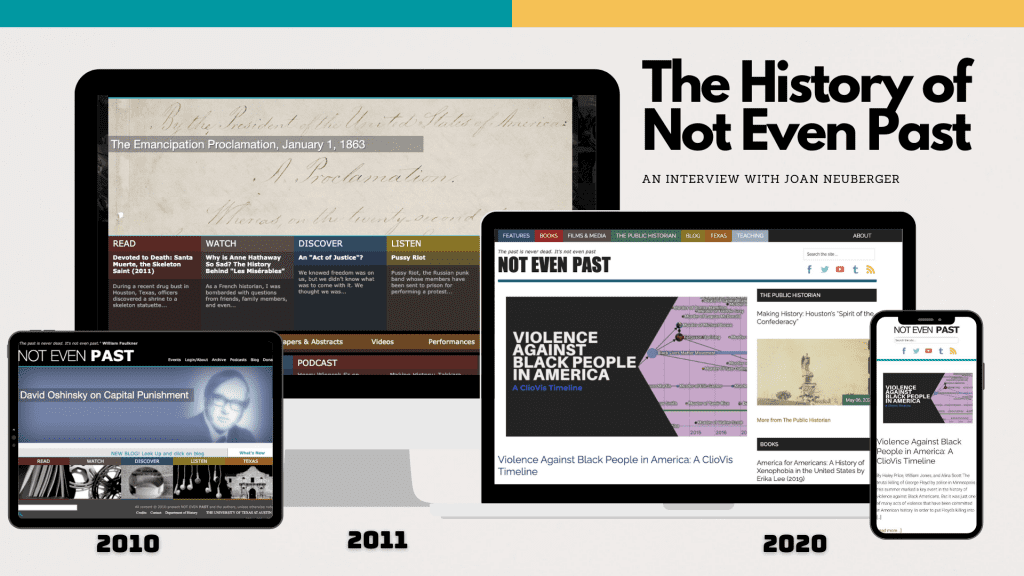
With Joan Neuberger
This is a conversation with Dr. Joan Neuberger, the Founding Editor of Not Even Past. Not Even Past was born in 2010 and launched in January 2011. In 2020, it marks its ten-year anniversary. Since its creation, the site has emerged as a robust and influential platform for Public History. This owes a great deal to the extraordinary work of Dr. Neuberger, who has expertly steered the site for the past decade. In this conversation, she reflects on the origins and development of Not Even Past and on some of her wider work in the field of Public History. The interview is best read alongside the tribute to Dr Neuberger, which can be seen here. The Not Even Past Conversations Series was born out of the extraordinary circumstances of the COVID-19 pandemic. It takes the form of an interview held informally (usually at home) over Zoom with leading scholars and teachers at the University of Texas at Austin and beyond. Here Adam Clulow speaks with Joan Neuberger.
AC: Could you explain what Not Even Past is to someone who isn’t familiar with the site?
AC: In 2020, we’re marking the 10th anniversary of Not Even Past. How did the idea for the site come about?
JN: The idea came from Alan Tully, who was chair at the time. Alan had put together the Visiting Committee, made up of alumni and donors and supporters of history to promote the department, and they came up with the idea of having a book blog so that people in the History Department would be able to recommend books for anyone who loved to read History. Alan presented the idea to the Executive Committee, which I happened to be on at the time, and I thought it was a great idea. I wasn’t writing my own blogs, but I was reading a lot of history blogs at the time, and generally spending a lot of time reading on the internet. And I was really enjoying the kinds of creative work historians were doing on the web. For example Edward Ayers’ site, “The Valley of the Shadow: Two Communities in the American Civil War” site or the work of James Billington, who was head of the Library of Congress on “Meeting of Frontiers,” comparing territorial expansion in the U.S. and the Russian Empire, were just two of the exciting things appearing online.
So I thought it was a great idea, but I also thought a book blog wasn’t really expansive enough to get attention and do what we wanted to do to promote the department. I thought it would be a good idea to make our project a kind of full-service History website. So that was how we got started. We began sketching out ideas with the help of George Christian in the English department in the spring of 2010 and then in the fall of 2010, we really started developing the website. With our departmental development advisor, Rick Geyer, we talked to designers, we gathered a couple of focus groups, we figured out what categories of articles we wanted to include, and then the “implementers” at LAITS constructed the site for us, and we launched in January 2011.
AC: Did you have any models in mind of other departments that might be doing something similar?
JN: I don’t think there was really anything like Not Even Past. To be honest, I didn’t have any idea what I was doing, and I didn’t really look around for models. What I was looking at were people who were doing really great blogging work in history, including some of our graduate students, such as Ben Breen, who had his own blog, Res Obscura, at the time. It just seemed to me to be a good idea to combine a lot of things that historians write about and put out a sort of general history website that would be appealing to the many people who like history.
AC: What was the original audience and how did this change over time?
JN: The original idea was to appeal to UT History alumni and to history buffs, whoever they might be. We had no idea how many people there were in these categories or who they would be. But we wanted to connect with alumni, both our undergraduate and graduate alumni, and we made the site to appeal more generally. When we started, I didn’t even know there was such a thing as Public History. And I didn’t know there was such a thing as Digital History. I was really in the dark and learned almost everything from trial and error. In the beginning, I learned a lot from Twitter, of all places. Twitter was a great way to learn about Public History and Digital History because public historians and digital historians were posting new projects all the time. I learned a great deal from public historians at the National Council for Public History, for example, about how people were using the Internet to reach out to potential readers and about how people wrote for the public. So I began with intuition and then drew ideas from all over the place.
AC: Can you tell us about how the structure of Not Even Past has evolved?
AC: Can you tell us about some of the contributions that have been most memorable to you or have drawn the most readers?
JN: Those are really two different categories. One of the articles that’s been really popular all along is a review that Nakia Parker wrote about Barbara Krauthammer’s book, Black Slaves, Indian Masters. Susan Dean Smith, one of our faculty members, wrote a very popular piece about Casta paintings that depicted people of mixed races in colonial Latin America. Jorge Cañizares-Esguerra wrote an article on the origins of the phrase, the “city upon the hill”, which Reagan and Kennedy used but which originated in a 17th-century New England sermon. Those are three perennially popular articles. We have a series of articles on the Vietnam War that Mark Lawrence wrote that are also really popular. But as I was going back and looking through the site, I realized just how many great articles we have posted over the years. And that really has nothing to do with me. The high quality of our archive is the product of the great historians among our faculty and grad students who are willing to write for the public.
One of the things that I wanted to do from the beginning was focus on subjects that are either absent from the school curriculum or poorly taught in our schools and the most obvious example was slavery. Around the time that we began, the state of Texas decided that one of its educational objectives was going to be to teach the so-called “good sides of slavery,” an incredibly outrageous and offensive idea. So from the beginning, I’ve wanted to feature African-American history and the history of slavery. And luckily, we’ve had some great historians either as visitors here through our Institute for Historical Studies or from our own faculty. Daina Berry in particular, our new chair and an important historian of slavery, has been regular contributor. As a result I think we have a solid body of articles on African-American history in general and the history of slavery, in particular.
We’ve also had great pieces on teaching history. We have Bob Olwell writing about using Reacting to the Past in his class, Debating the American Revolution. Eyal Weinberg and Blake Scott wrote a wonderful piece on using music in the classroom. Nakia Parker also wrote an inspiring piece on using popular culture in the classroom and Karl Miller, a former colleague, and Penne Restad, who is retired, wrote about innovations in teaching the U.S. history survey, all of which together form a rich resource for teachers thinking about teaching history.
AC: Beside faculty in the Department of History, who else has contributed to the site over the years?
JN: We feature a book or a project every month and for the most part, those are usually UT History faculty. But we also have reached out to people doing history in other departments. So, for example, we featured a book by Julia Mickenberg in American Studies on American leftist women who went to the Soviet Union in the 1920s and 30s. We featured Stephanie Jones-Rogers last year, when her incredible book on white women who owned slaves had just come out and then won multiple awards. Jen Graber in Religious Studies writes about Native American religion. We featured her work on the site and also Ted Gordon, who is now the UT Vice Provost for Diversity. For many, many years, Ted Gordon has been running something called the Racial Geography Tour of the UT campus. When our designer in LAITS, Stacy Vlasits, helped him put the tour online, we did a feature on the new digital Racial Geography Tour. John Morán González did a fantastic project with a group of people at the Bullock History Museum, the Texas History Museum across the street from campus, on the violence against Mexican Americans at the beginning of the 20th century called Refusing to Forget. We featured his work on 15 Minute History and on Not Even Past.
AC: Why do you think it’s important for a History department to have a site like this?
JN: I think it’s really positive for the History Department to be working on reaching out to people other than fellow academics. And I think that everyone who has written for Not even Past appreciates being in an institution that is actively practicing Public History. In addition, we have tons of data showing us that employers of all kinds want people with humanities degrees, that employers want the skills that history majors have. But we still live in a world where the humanities is denigrated constantly. And so I think it’s extremely important for us to be producing high-quality history writing that is based on evidence, that focuses on important topics, and that is available to anyone in the public who wants it.
I also think that Not Even Past has provided important writing and publishing experience for the graduate students who’ve submitted articles. One of the completely unexpected things that happened is that Not Even Past turned out to be a kind of writing workshop for graduate students. I do a lot of intensive editing of all submitted material as I have had a very high standard for the quality of writing that we post. I want only to publish articles with arguments that are clearly based on documentary evidence and I want all our writing to be accessible and clear. One of the things I”ve enjoyed most about editing Not Even Past has been the chance to work with grad students I would never have otherwise met. I’ve argued from the beginning that if students can write good clear sentences and make their ideas easily understood, they would be better academic history writers.
AC: What kind of support have you received from the department and the university across the past ten years of Not Even Past?
JN: We’ve had incredible support from the College of Liberal Arts and the Department of History. Most people I know at other universities who are trying to do podcasts or websites or blogs don’t have anywhere near the kind of financial and technical support that we’ve had under both Alan Tully and Jackie Jones. I’ve had a graduate student Assistant Editor every year for Not Even Past, and for 15 Minute History, we have a professional recording studio with an extraordinary staff, led by Jacob Weiss and Michael Heidenreich, who edit all of our podcasts. They do a superb job for us. When we did more videos, we also had a video staff at LAITS.
AC: Can you tell us about 15 Minute History, which is attached to Not Even Past and has been extraordinarily successful?
JN: 15 Minute History is a project that I started with a graduate student in Middle Eastern History, Chris Rose. Before doing his Ph.D. in History, Chris worked as Outreach Coordinator for the Center of Middle Eastern Studies. Because I was editing Not Even Past, he came to me one day to brainstorm about doing something else specifically for high school teachers to provide sources for them about World History, in particular about subjects that were being distorted in the Texas state requirements for K-12 teachers. His field of Middle Eastern history and the history of Islam were represented in the state standards and textbooks almost uniquely through terrorism, ignoring the incredibly rich history and culture of the Middle East.
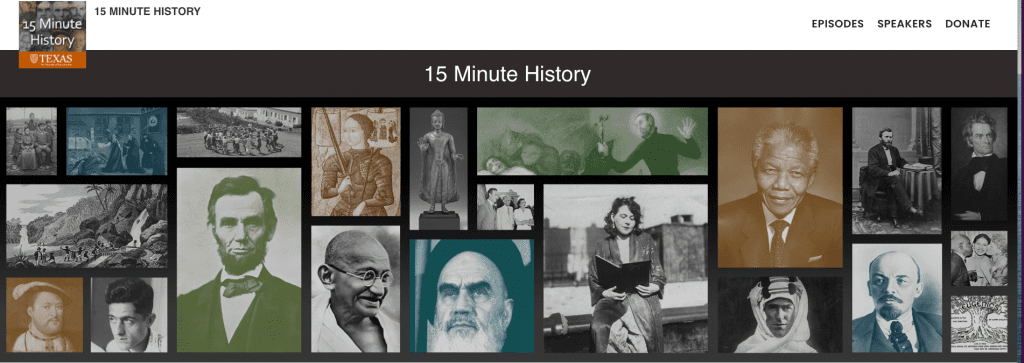
We came up with the idea of a podcast. We did a couple of trial episodes, which became episodes 1 and 2, that are slightly embarrassingly stiff. But we learned how to conduct interviews in a more conversational style as time went on. At first, we had a reasonable rate of listeners for a new podcast but then we had an incredible stroke of luck when the UT PR department tweeted about us. The podcast was on iTunesU at the time and Apple retweeted our UT PR tweet. All of a sudden we went from having 300 to 3000 and then 30000 listeners. And then we became the top-ranked podcast on iTunesU. We weren’t the number one history podcast in the world, that is a whole different universe but among academic podcasts, we were ranked number one or number two from about 2013 until ITunesU was discontinued. We alternated with a UCLA meditation podcast for a long time. And so we had some luck but then also, as people discovered us, they found that they really liked the podcast. And gradually it became a little bit less oriented towards teaching. A lot of students still use it and we recommend it all the time for faculty to include in their curricula, on their syllabi, and so on.
AC: In 2018, you received the Herbert Feis Award from the American Historical Association for distinguished contributions to Public History. You worked on many other public history projects but one that stands out particularly for me is ‘Behind the Tower’ which documents the 1966 Tower shooting and which I read before arriving in Austin. Could you tell us more about that?
AC: Thank you for joining us and for your incredible work on Not Even Past.
The views and opinions expressed in this article or video are those of the individual author(s) or presenter(s) and do not necessarily reflect the policy or views of the editors at Not Even Past, the UT Department of History, the University of Texas at Austin, or the UT System Board of Regents. Not Even Past is an online public history magazine rather than a peer-reviewed academic journal. While we make efforts to ensure that factual information in articles was obtained from reliable sources, Not Even Past is not responsible for any errors or omissions.
